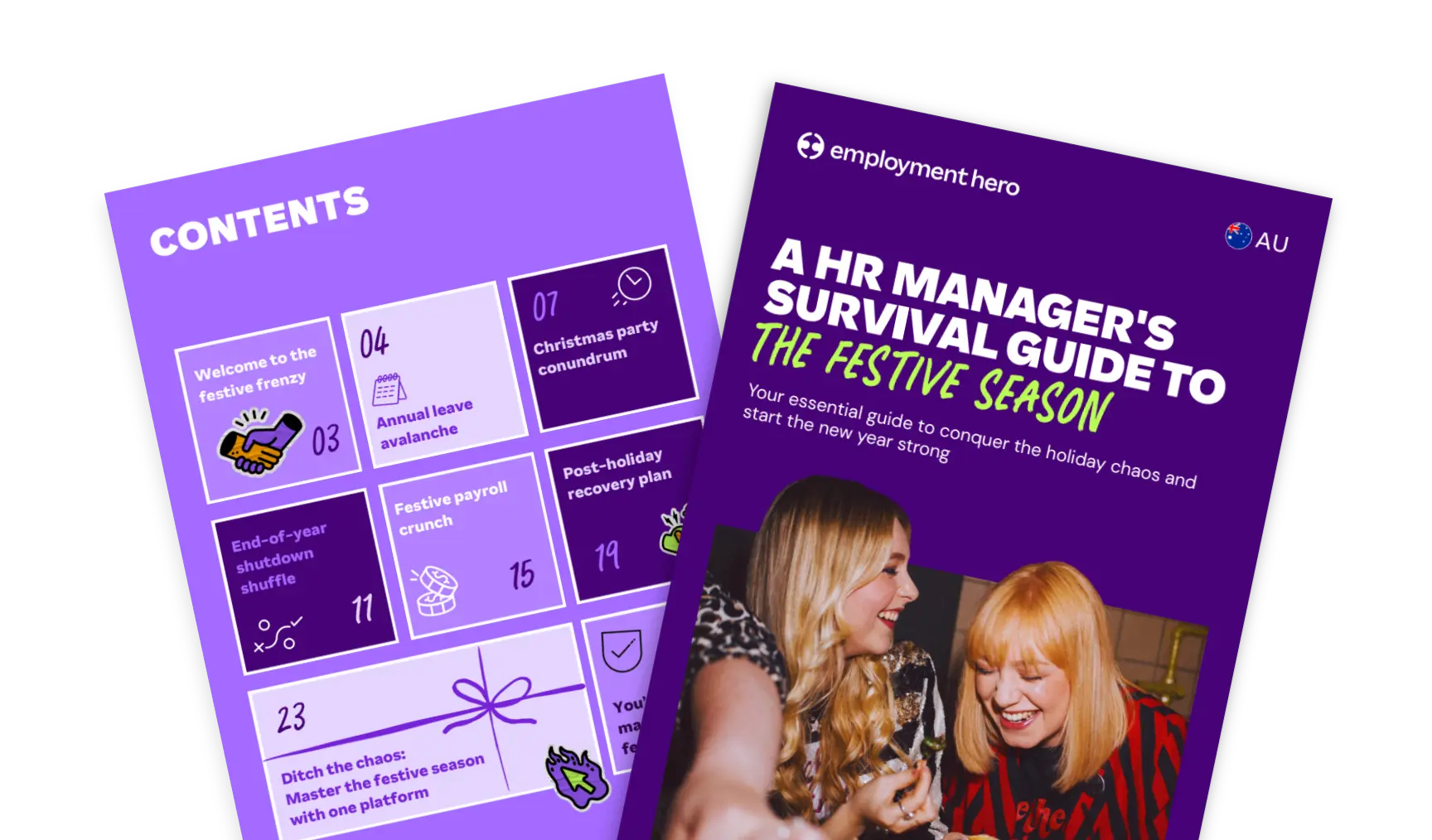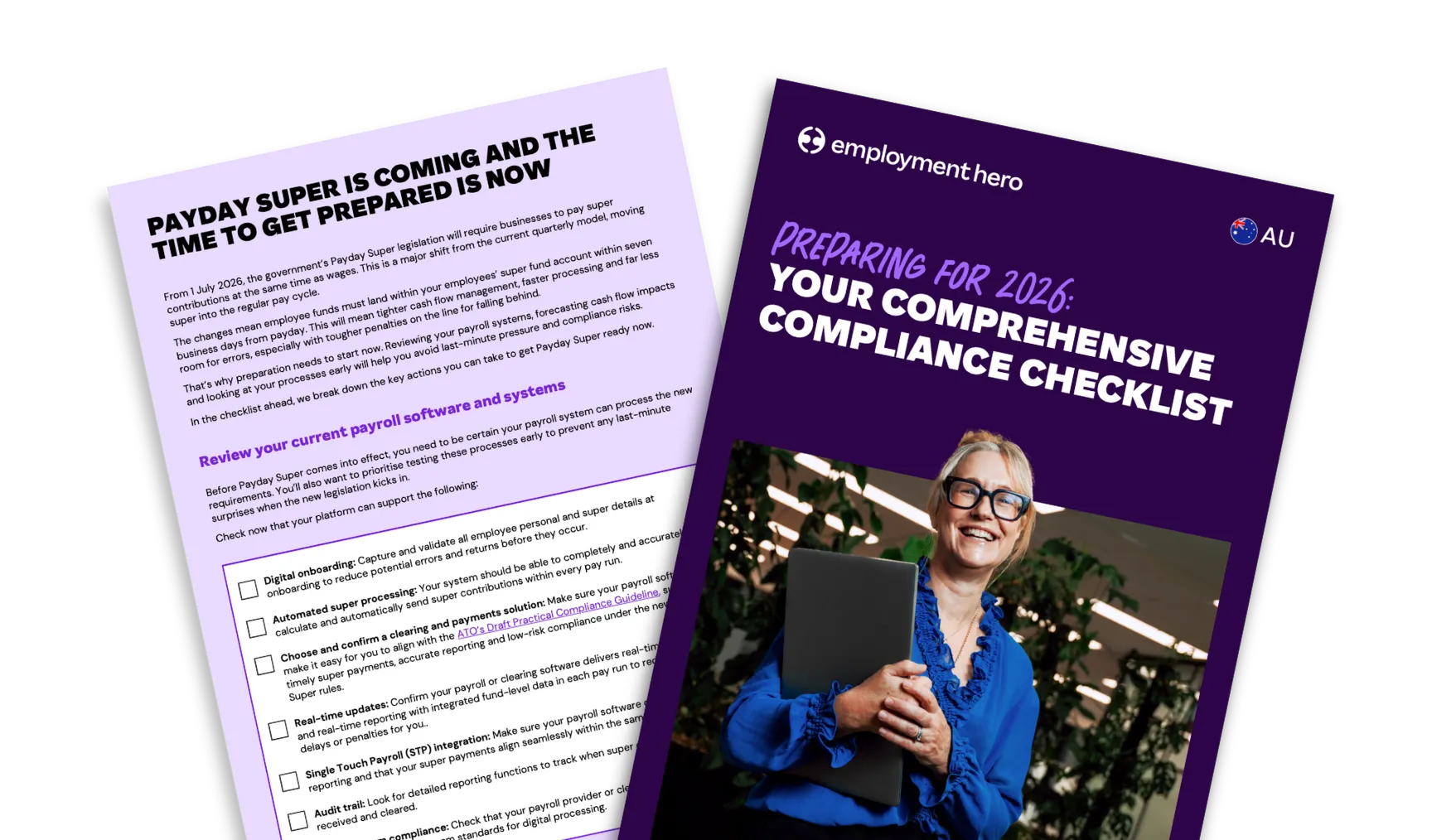Employee offboarding checklist template for Australian businesses
Published
Employee offboarding checklist template for Australian businesses
Is your organisation prepared for when valued team members move on?
Your employee offboarding checklist needs to be as thoughtful as your welcome process, ensuring that when an employee leaves, both they and your company can transition smoothly with all loose ends properly tied up.
What’s in this guide?
When an employee’s departure is on the horizon, having a structured approach makes all the difference to both your business and the outgoing employee. That’s why we’ve created this comprehensive employee offboarding checklist, with all of the important tasks that HR managers and business leaders should implement for a great offboarding experience.
Let’s make that final goodbye one to remember, for all the right reasons.
This guide covers:
- Steps to take before the employee departs: From the moment an employee gives notice, you’ll need to initiate your offboarding process by documenting their resignation, planning the employee’s resignation announcement, arranging knowledge transfers, and preparing all necessary paperwork.
- Things to remember during the offboarding process: As the departure date approaches, your focus shifts to securing company data by revoking IT access, recovering all company assets from the departing employee, conducting a thorough exit interview, and ensuring a proper handover of responsibilities to minimise disruption.
- After the employee leaves: Once your employee has left, you’ll need to finalise administrative tasks, complete legal requirements and support your remaining team members through the adjustment period.
What is offboarding, and what is its significance?
Offboarding is the structured process your organisation follows when an employee leaves, encompassing everything from their resignation notice to termination of employment and beyond. Similar to your onboarding process, it is designed to ensure both your existing employee and your company transition smoothly when professional paths diverge.
Why should you care about creating a thorough employee offboarding process?
- For your departing employee: It provides closure, ensures they receive all entitled benefits, and leaves them feeling respected. This positive final impression can transform your former employees into valuable brand ambassadors.
- For your company: Effective offboarding protects your interests by securing sensitive information, recovering company assets, and maintaining business continuity. Your exit interviews also provide golden opportunities to gather honest feedback about what is and isn’t working in your organisation.
In smaller teams, where each role often carries significant responsibility, your offboarding process becomes even more crucial. Without proper handover procedures, vital knowledge can disappear overnight, leaving your remaining team members scrambling to fill gaps while trying to maintain daily operations.
With remote work, your offboarding checklist becomes absolutely necessary. When an employee leaves your remote team, you miss the physical cues that typically signal a departure. Without a structured process, essential steps like recovering your company equipment, revoking digital access, and properly acknowledging your employee’s contribution can easily slip through the cracks.
Your consistent offboarding process also helps protect against potential legal vulnerabilities. When an employee leaves, having documented procedures ensures you meet your obligations regarding final pay, benefits continuation, confidentiality agreements, and other legal requirements that apply to your former employees.
What should be covered in the exit interview?
The exit interview represents your most valuable learning opportunity in the entire offboarding process. This conversation offers a unique window into your departing employee’s experience—insights that your current staff might be hesitant to share. Your goal should be to create an atmosphere where they feel comfortable providing honest feedback while you gather information to improve your workplace.
Finding the right balance is essential. While you’re collecting important data, this is also a human moment. How you conduct this interview will form part of their lasting impression of your company.
Here’s what your exit interview should cover:
- Their overall experience: Ask what they enjoyed most and least about working with your organisation. This provides context for their departure and highlights both strengths and improvement areas.
- Reasons for leaving: While they may have given an official reason, the exit interview offers space for more nuanced discussion. Listen without judgment to understand what truly influenced their decision.
- Feedback on management: Create a safe space for honest reflections on their reporting relationships. This feedback can be invaluable for developing your leadership team.
- Role satisfaction: Explore whether they felt their skills were well-utilised and if they had sufficient growth opportunities. Use this insight to refine roles for your remaining team members.
- Team dynamics and culture: Invite observations about your working relationships and communication patterns. Your former employees often have the clearest perspective on your actual culture.
- Recommendations for improvement: Ask directly what changes they would suggest to make your organisation better. Their outside perspective may identify blind spots.
When an employee leaves under difficult circumstances, whether due to performance issues or conflicts, approach the situation with extra care. Consider having someone neutral conduct the interview, acknowledge any tensions without dwelling on them, and focus on gathering constructive feedback rather than justifying the decisions.
Most importantly, thoughtfully conducted exit interviews provide valuable insights that can help shape your retention strategies and enhance your overall employee experience. The patterns that emerge across multiple departures can signal essential opportunities for improvement in your organisation.
And if you are looking to free your HR team from the administrative burden of employee departures, explore how offboarding software can streamline your process, allowing you to focus on the human conversations that truly shape your company’s future.
Best practices for recovering company assets
Let’s address a crucial aspect of offboarding that deserves your attention: recovering company assets when an employee leaves. This task often gets overlooked in the flurry of exit interviews, farewell events, and knowledge transfers.
Many organisations find themselves awkwardly chasing former employees for laptops, security passes, or mobile phones weeks after their departure. Beyond the financial impact of unreturned physical items, there’s also the critical matter of protecting your company’s intellectual property and data.
Here’s how you can ensure a smooth recovery process after conducting your exit interview:
- Create a comprehensive asset register: Maintain an up-to-date record of all items assigned to each employee so you have a clear checklist during offboarding (Employment Hero can help!).
- Communicate expectations early: When an employee gives notice, include a friendly reminder about returning company assets in your acknowledgement.
- Designate a specific return procedure: Make the process straightforward by clearly stating how and where items should be returned, with special considerations for remote teams.
- Document everything: As items are returned, record their condition with the departing employee’s sign-off to prevent future disagreements.
- Address digital assets – Ensure your IT team has a process for revoking system access, transferring ownership of files, and confirming company data removal from personal devices.
- Have a follow-up plan: Establish a clear, professional process for following up if you discover unreturned assets after the employee’s departure.
When handled thoughtfully, recovering company assets becomes a smooth part of your offboarding process rather than an uncomfortable afterthought, helping you maintain both security and a positive relationship with your outgoing employee.
How should businesses reassure remaining team members?
When an employee leaves, your remaining team members will inevitably have questions and concerns about what happens next.
Their reactions can range from anxiety about increased workloads to uncertainty about the future of your organisation. Addressing these concerns promptly and thoughtfully is essential for maintaining morale and productivity during this transition period.
Ensure a consistent offboarding process
Your consistent offboarding process reassures your remaining team members that departures are handled professionally and respectfully. When your team sees that you have clear procedures in place, they understand that employee transitions are a normal part of business, not a cause for alarm. This predictability reduces uncertainty and builds trust in your leadership during periods of change.
That’s where following a structured offboarding checklist comes in, which covers all necessary steps, from knowledge transfer and communication plans, to asset recovery and access revocation. Share this process with your management team so departures are handled with the same level of care regardless of who oversees them.
Ensure clear communication about the offboarding process
When an employee’s departure is announced, your remaining team members will immediately wonder what this means for them. Transparent communication helps manage concerns before they escalate into rumours or anxiety. Schedule a team meeting promptly after the departure announcement to address questions directly.
As a manager, you should share appropriate details about how the transition will be managed, including knowledge transfer plans, redistribution of responsibilities, and your timeline for replacing the departing employee if applicable. Be honest about short-term challenges while emphasising the team’s capability to adapt. Avoid vague statements that might fuel speculation, instead focusing on concrete next steps your team can expect.
Addressing concerns about workload and responsibilities
One of your team’s immediate concerns will be who takes over the departing employee’s tasks. Create a clear, fair plan for redistributing essential responsibilities during the transition period. Involve your team in discussions about interim workload sharing, acknowledging that temporary adjustments may be necessary while avoiding permanent overloading.
As their leader, consider which projects can be paused temporarily and which require immediate attention. Document how each critical responsibility will be covered and for how long, with realistic timelines for any recruitment plans. If appropriate, view this as an opportunity to create development opportunities for team members interested in stretching their skills or testing new areas of responsibility.
Acknowledging the emotional impact of a colleague’s departure
Your team isn’t just losing a functional role, they’re losing a colleague they’ve built a relationship with. Create space for your team to acknowledge this emotional aspect by allowing appropriate goodbyes through farewell gatherings or cards. Monitor team morale in the weeks following the departure, checking in informally with individuals who worked closely with the departing employee.
Recognise that different team members may react differently based on their relationship with the person leaving. Some may feel betrayed, while others might worry about their own job security. As a manager, listen to these concerns without judgment and reassure your team about their value to the organisation through both words and actions.
Creating opportunities for team-building after an employee leaves
The departure of a team member inevitably changes your team dynamics. Use this transition as an opportunity to strengthen remaining bonds and establish new connections. Schedule team activities that allow for informal interaction and rebuilding of relationships within the revised team structure.
Consider team workshops focused on clarifying roles and communication patterns, particularly if the departing employee played a central role in information flow. Create opportunities for cross-training to increase versatility and deepen collaboration between team members who may not have worked closely before. These investments demonstrate your commitment to team cohesion beyond individual comings and goings.
Managing offboarding for remote teams
With remote work becoming standard practice for many organisations, it’s important your offboarding processes adapt to this way of working. Whether your company operates as a fully distributed team, embraces a hybrid model, or occasionally brings on remote talent for specific projects, the way you handle employee departures must adapt accordingly.
Offboarding remote team members presents unique challenges that require thoughtful consideration. Without the physical presence that traditionally marks an employee’s departure such as clearing out a desk, attending a farewell lunch, or handing over equipment in person, remote offboarding can feel less tangible and more abrupt for everyone involved.
Beyond your standard offboarding protocol (which typically includes revoking system access, arranging equipment returns, and conducting exit interviews), here are key considerations that can make a significant difference when managing remote departures:
- Navigate cultural nuances: For international remote teams, be mindful that resignation notice periods, exit expectations, and farewell customs vary significantly between countries. What feels appropriate in one culture may seem abrupt or overly formal in another.
- Preserve digital knowledge: Establish clear protocols for reviewing and archiving digital workspaces, chat histories, and shared drives that contain institutional knowledge. Remote employees often build extensive digital trails that contain valuable information not captured in formal handovers.
A thoughtful and well-executed remote departure demonstrates your commitment to treating distributed team members with the same care and respect as your office-based colleagues. This reputation will serve you well in attracting future remote talent.
Common offboarding mistakes to avoid
Despite your best intentions, offboarding processes can sometimes fall short due to common oversights and missteps. Being aware of these pitfalls can help you refine your approach and ensure each employee’s departure is handled with the care and attention it deserves.
Here are the key mistakes to avoid when managing your offboarding process:
- Treating offboarding as an afterthought: Unlike the careful planning often devoted to onboarding, departures are frequently handled reactively. Develop a proactive offboarding strategy that receives the same level of consideration as your welcoming process.
- Neglecting the departing employee’s experience: Once notice is given, some managers emotionally disengage or treat the employee as already gone. Remember that how you handle their final weeks significantly impacts their lasting impression of your organisation.
- Failing to capture critical knowledge: Rushed handovers often miss valuable knowledge that isn’t documented in standard processes. Schedule multiple knowledge transfer sessions focused on different aspects of the role to ensure comprehensive coverage.
- Overlooking security considerations: Beyond obvious steps like revoking system access, consider less visible security touchpoints such as shared passwords, client relationships, and social media accounts that may need attention.
- Waiting until the last day for asset recovery: Leaving equipment collection to the employee’s final hours creates unnecessary pressure. Develop a staggered approach to recovering items that aren’t needed for their remaining work.
- Forgetting to inform external stakeholders: Clients, vendors, and partners who worked closely with the departing employee should be notified appropriately to ensure relationship continuity and prevent confusion.
- Missing the opportunity for genuine feedback: Conducting exit interviews that only ask surface-level questions wastes a valuable opportunity to gain honest insights that could help improve your workplace.
By avoiding these common pitfalls, you’ll create a more thoughtful offboarding experience that protects your organisation while respecting the departing employee’s contributions, setting the stage for possible future reconnections, and preserving your reputation as an employer.
Want to turn employee departures into opportunities rather than headaches? Download our complete offboarding checklist today.
Looking for added support to streamline your HR? Our Employment Operating System, and expert HR advisory team can help.
Register for the checklist
Related Resources
-
 Read more: HR Managers: Don’t just survive the festive season, master it
Read more: HR Managers: Don’t just survive the festive season, master itHR Managers: Don’t just survive the festive season, master it
Make year-end easier: manage leave, payroll, parties and shutdowns with confidence. Get practical tips for Australian SMEs. Download the free…
-
 Read more: Preparing for 2026: Your Compliance Checklist
Read more: Preparing for 2026: Your Compliance ChecklistPreparing for 2026: Your Compliance Checklist
Get your business ready for the 1 July 2026 changes. See practical steps for Payday Super, cash flow planning and…
-
 Read more: Monthly business budget template for employers
Read more: Monthly business budget template for employersMonthly business budget template for employers
Plan your monthly income and expenses with our free monthly business budget template. Download today to track cash flow and…























